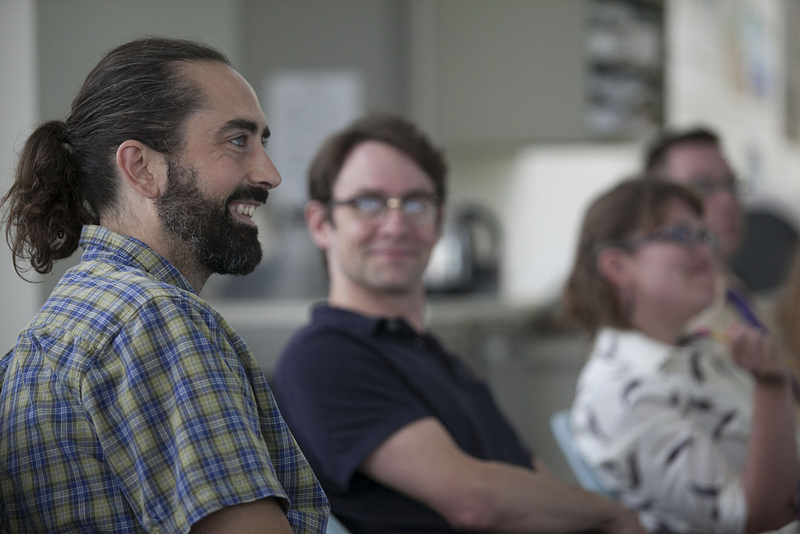
Whether deconstructing plant material in his own Fort Atkinson High School classroom, or collecting biofuel conversion data in coordination with colleagues in his district, biology teacher Marin Dobson has led the way in integrating his experiences with the Great Lakes Bioenergy Research Center (GLBRC) into a compelling scientific curriculum reaching every student in his department.
Dobson first became aware of GLBRC and its education and outreach programs when he participated in the Bioenergy Institute for Educators (BIE) program in the summer of 2010. There he learned about recent bioenergy breakthroughs as well as how to implement concepts used in modern bioenergy science into his own teaching.
He then returned to GLBRC in 2013 to participate in the Research Experience for Teachers (RET) program. The RET program, held every summer at the Wisconsin Energy Institute and Kellogg Biological Station in Michigan, pairs K-12 educators with GLBRC scientists and curriculum development teams.
During a seven-week residency, participants conduct cutting-edge bioenergy research alongside the Center’s diverse research groups in areas of renewable energy, ecology, biofuels, and energy systems. Following this immersive research experience, participants work with educational science professionals to translate their experiences and findings into materials for their own classrooms.
Working in the Brian Fox laboratory with researchers Shishir Chundawat and Kate Helmich, Dobson analyzed the composition of cell walls to better understand why some plant materials yield more biofuel products than others.
Dobson’s work contributed to the research findings of the laboratory, but also to the development of one of GLBRC’s best-received educational materials package, Converting Cellulosic Biomass to Ethanol (CB2E).
The CB2E lab engages students in the process of biofuel production as they convert cellulosic biomass sources, such as sawdust, straw, or cardboard into sugars and then ethanol. As the biomass is treated, digested, and fermented, students use an array of measurement devices to determine the products of the chemical conversion. In the process, students test predictions about which types of biomass sources and treatment methods will be most effective for producing ethanol.
With both an integrative biology education workshop and a pioneering research experience under his belt, Dobson returned to his classroom with broadened perspective. He worked with his colleagues to incorporate a variety of GLBRC activities that teach core concepts such as photosynthesis, respiration, biomolecules, and ecology into the high school’s curriculum.
The CB2E lab served as a capstone activity requiring students to synthesize everything they’d learned throughout the semester. As a result, hundreds of students across ten sections of biology at Fort Atkinson High School were able to share, compare, and discuss their biofuel conversion results from biomass samples including straw, cardboard, and switchgrass.
Dobson says the CB2E activity brings biology into contemporary relevancy for his students, urging discussions about salient issues such as emissions, climate change, and sustainability. But he also uses Life Cycle Analysis activities, the Fields of Fuel videogame, and one of his personal favorites, Fast Plants® projects.
“One activity I like to use is the growing fast plants in the dark and in the light […] as a way of introducing a surprising outcome to the lab,” says Dobson.
The activity, known as “Exploring Energy Transformations in Plants”, challenges students to consider why plants grow faster and taller in the dark as opposed to in the light, in the process learn about key energy transformations associated with photosynthesis and respiration.
“There are definitely ‘a-ha’ moments of surprise,” Dobson says, describing his students’ shock as they take their measurements of plant growth in the dark.
“[It all] elicits some pretty cool reactions.”
According to GLBRC education and outreach coordinator Leith Nye, Dobson’s appreciation of GLBRC educational materials is more than matched by his own admiration for Dobson’s energy in bringing contemporary science into his classroom.
“Marin is a great example of how the GLBRC biofuels curriculum can be integrated really effectively into a standard high school biology curriculum,” Nye says. “But Marin also took the tools and training we offer and just ran with them, offering valuable feedback and improvements along the way. He has a real gift for teaching core concepts and skills in a fun, engaging, and relevant way.”
Dobson’s pursuit of new and exciting ways to engage with modern science has resulted in a more enjoyable and thought-provoking education for both him and his students.
But as Dobson proclaims, his success can be others’ as well.
“I would recommend trying one of the summer educational programs for teachers to learn about the activities and see how they could be incorporated into the classroom experience,” advocates Dobson.
“There is a lot of good stuff there, as I can personally attest.”
For more information on GLBRC’s education and outreach activities and events, visit https://www.glbrc.org/education.